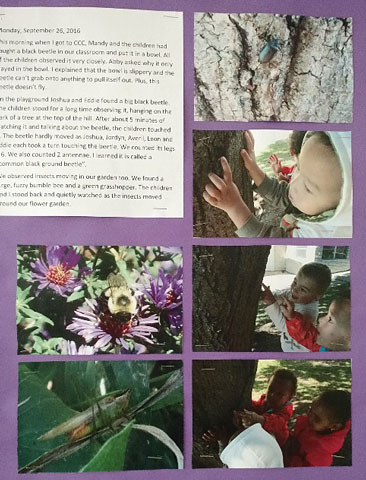I recently had an interesting discussion with teachers at a child care center about displaying documentation. The teachers had been implementing the Project Approach with their students for several years and were already in the habit of displaying documentation of the children’s project work throughout their center. They were preparing to display some of this work at a statewide meeting of teachers who implement projects, and they were suddenly very anxious about whether they were displaying documentation “correctly.” Following our discussion, I agreed to send them a list of my thoughts on preparing documentation displays. These thoughts centered on several strategies for supporting the viewer of the display, including the following:
- Consider the Purpose of the Display. A teacher may select samples for a display for several different purposes. One purpose might be to document the growth in knowledge, skills, or dispositions of a child or a group of children. Another purpose might be to show growth and change in her own teaching or within a learning community. For example, she may believe the collection of samples reveals the way a particular child or group of children benefited from participation in a learning experience. Or she may intend to document the way children of a particular age learn. However, without an explanation or guide, those who view the documentation display may not recognize its significance. Instead, they may look at a display of children engaged in a remarkable learning experience and say something like, “Isn’t that cute?” Consequently, it is helpful for teachers to provide supports that enable the viewer to become aware of and consider certain aspects of their displays that they feel are especially important. These supports might be as subtle as including a question in the display that prompts the viewer to consider or analyze particular aspects of the display. More direct supports for the viewer might include a narrative in which the teacher shares her insights into the meaning of the events she has documented.
- Format the Display Strategically. A teacher can also help the viewer comprehend the significance of the documentation through strategic formatting of the display. She can do this by manipulating the size and arrangement of the samples. For example, if the teacher wants to emphasize the process a child went through as he figured out how to build a bridge with unit blocks, she might display a series of photographs taken of the child as he engaged in the processes. Showing the child’s early attempts—and his failures—can provide more information about the child’s persistence and learning than a single picture of the child and his completed bridge. Similarly, displaying a series of the drawings or writing samples that have been collected over time can reveal the development of a child’s knowledge, skill, or disposition. Surrounding such a series of pictures or writing samples with white space and arranging them close together in sequence will support the viewer’s understanding that these samples are related.
- Collaborate with Others to Anticipate the Viewer’s Need for Support. Displaying documentation of children’s learning is an important and challenging practice for teachers. By taking a minute to step back and view the display as an outsider, teachers can look for ways to provide supports that will boost the viewer’s understanding. However, it can be difficult to adopt this outsider viewpoint. Before permanently attaching documentation samples to the display, it can be helpful to invite another teacher or a parent to view and respond to the display. Collaborating with others to help anticipate the viewer’s experience can help teachers prepare the display to better support the viewer.
There are many things to consider in creating effective documentation displays. Taking the time to thoughtfully add supports for viewers is one way to increase the value of the display. With a little support, viewers may be able to share the teacher’s insights into children’s learning. Instead of “Isn’t that cute!” the teacher may hear, “Isn’t that interesting!”

Sallee Beneke
Sallee (BenekeSalleeJ@sau.edu) is Professor and Director of Graduate Programs in ECE at St Ambrose University, Iowa. She coauthored The Project Approach for All Learners (2019) with Michaelene Ostrosky and Lilian Katz. Sallee used the Project Approach as a teacher and has worked to build the implementation of the approach via training and consulting. Sallee co-founded the IEL Project Approach Web site, and Facebook page with Lilian Katz, and she continues to contribute to the site.
Biography current as of 2021


